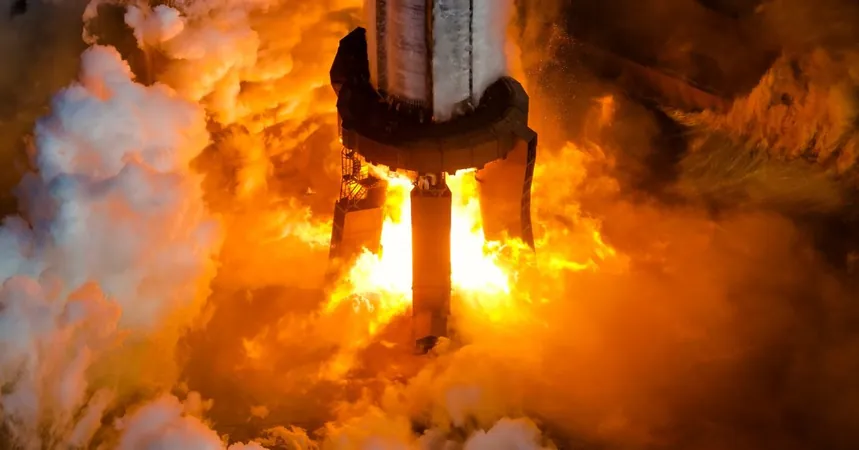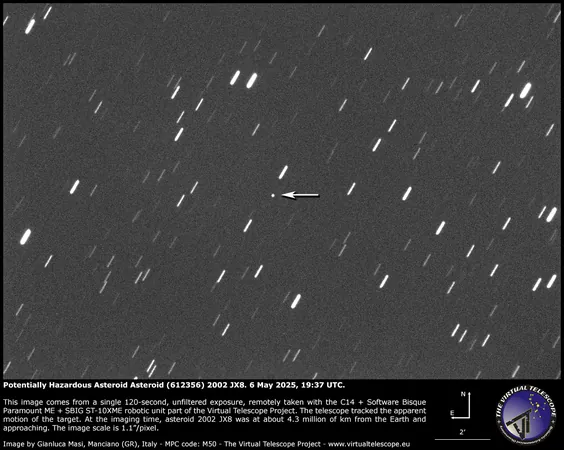
SpaceX's Starship Flight 9 Set to Make History with Reused Booster!
2025-04-07
Author: Jacob
Introduction
In an exciting development for space exploration enthusiasts, SpaceX has confirmed that its upcoming Starship Flight 9 mission will utilize the Booster from Flight 7 for the first time, marking a significant milestone in the journey towards operational reusability. This means that the company is one step closer to achieving its goal of creating a fully reusable rocket system, which would revolutionize space travel.
Static Fire Test of Booster 14
On Thursday morning, SpaceX conducted a remarkable static fire test on Booster 14 at Launch Pad A. This test was particularly significant because it involved a booster that has already been flown, making it a pioneering event in the history of SpaceX's operations. Booster 14 first took to the skies on January 16, 2025, during the debut of the Starship Block 2 Ship design. Though the initial mission was intended as a suborbital certification flight before moving on to an orbital mission with Flight 8, it encountered an issue that halted its ascent. This setback resulted in a reattempt during Flight 8.
Historical Context and Challenges
Despite the challenges faced, Booster 14 returned to the launch pad safely, being captured by the tower's arms—a feat achieved successfully for the second time after the first incident with Booster 12 on Flight 5. However, it appears that Booster 12 will not be reused for future flights.
Significance of the Static Fire Test
The static fire test of Booster 14 stands out as the first time a flight-proven booster has engaged in this essential step, signaling progress in SpaceX's plans. While we await the exact launch date for Flight 9, SpaceX CEO Elon Musk hinted on social media that we can expect the “First reflight of the Starship Super Heavy rocket booster coming up soon!” However, with the investigations into Flights 7 and 8 still ongoing, it remains uncertain when Flight 9 will actually take place. Both previous flights experienced similar failures during critical phases of their ascent.
Future Objectives of Flight 9
Flight 9 is expected to follow a suborbital profile, just like its predecessors, with the primary objectives of demonstrating an in-space re-ignition of a Raptor engine and deploying dummy Starlink satellites. As the program continues to face hurdles, the recent setbacks underscore the importance of gathering flight data to refine and enhance the Starship design.
Implications for NASA's Artemis Program
Moreover, the timeline for Starship is crucial as it is part of NASA's Artemis Program, intended to facilitate human landings on the Moon. With new leadership potentially on the horizon, including Jared Isaacman likely slated to be confirmed as NASA Administrator, the future of this ambitious program remains in flux. As Elon Musk continues to innovate, Starship's progress may very well dictate the pace of humanity's next leap into space.
Conclusion
Stay tuned, as the coming months promise to be a thrilling period for both SpaceX and the global space community, with the potential for significant advancements in rocket technology!









 Brasil (PT)
Brasil (PT)
 Canada (EN)
Canada (EN)
 Chile (ES)
Chile (ES)
 Česko (CS)
Česko (CS)
 대한민국 (KO)
대한민국 (KO)
 España (ES)
España (ES)
 France (FR)
France (FR)
 Hong Kong (EN)
Hong Kong (EN)
 Italia (IT)
Italia (IT)
 日本 (JA)
日本 (JA)
 Magyarország (HU)
Magyarország (HU)
 Norge (NO)
Norge (NO)
 Polska (PL)
Polska (PL)
 Schweiz (DE)
Schweiz (DE)
 Singapore (EN)
Singapore (EN)
 Sverige (SV)
Sverige (SV)
 Suomi (FI)
Suomi (FI)
 Türkiye (TR)
Türkiye (TR)
 الإمارات العربية المتحدة (AR)
الإمارات العربية المتحدة (AR)